Analysis of Two-Level Mesh Method for Partial Integro-Differential Equation
Abstract
In this paper, we present two-level mesh scheme to solve partial integro-differential equation. The proposed method is based on a finite difference method. For the first step, we use finite difference method in time and global radial basis function (RBF) finite difference (FD) in space. For the second step, we use the finite difference method to solve the proposed problem. This two-level mesh scheme is obtained by combining the radial basis function with finite difference. We prove the stability and convergence of scheme and show that the convergence order is O(τ2 + h2), where τ and h are the time step size and space step size, respectively. The results of numerical examples are compared with analytical solutions to show the efficiency of proposed scheme. The numerical results are in good agreement with theoretical ones.
1. Introduction
This kind partial integro-differential equation is indicated by Volterra [1]; the new results of Volterra partial integro-differential equation can be found in [2, 3]. The problem Equation (1) can be found in the model of heat flow in a conducting materials with memory [4–7] and in viscoelastic mechanics [8–10].
Some attention has been paid to numerical methods of Equation (2), such as spectral collocation approximation by Kim and Choi [11], orthogonal spline collocation by Yan and Fairweather [12], alternating direction implicit difference scheme by Qiao and Xu [13], finite difference scheme by Tang [14], and compact difference scheme by Luo et al. [15]. If A is nonlinear operator, the numerical investigations for Equation (1) have been studied by several authors; one can refer to [16–18]. If we replace ∂u(x, t)/∂t with a fractional differential operator, then the fractional integro-differential equations can be obtained. The numerical solutions of fractional integro-differential equations have been studied by several authors; one can refer to [19–23].
Radial basis function, as a meshless method, has advantage of the ability to handle scattered node layouts and has the characteristics of simple implementation and high precision. The mainly purpose of this paper is to construct a numerical scheme using RBF and FD to solve partial integro-differential equation. In recent years, there are many researchers that studied the meshless method for solving partial differential equations. For example, Oruç developed a meshless approach based on radial basis function-finite difference (RBF-FD) method for solving one-dimensional, two-dimensional, and three-dimensional Schrödinger system [24, 25], two-dimensional fractional cable equation [26], and wave equations [27, 28]. Nikan and Avazzadeh [29] constructed an improved localized radial basis-pseudospectral numerical method for solving fractional reaction-subdiffusion equation.
This paper is outlined as follows. In Section 2, we introduce some notations and lemma and propose a two-level mesh discrete scheme based on finite difference. In Section 3, we discuss the stability and error estimation of the constructed discrete scheme. In Section 4, we consider the two-level algorithm which will be used in practical calculation. For more details on a two-level method, see [30, 31]. In Section 5, the results of numerical experiments are compared with exact solution to confirm the efficiency of the proposed discrete scheme. Finally, the conclusion and future studies are given for this paper in Section 6.
2. Construction of Numerical Scheme
Throughout this paper, the values of C in different places are allowed to be different. Lemma 1 will be used in the construction of numerical scheme.
Lemma 1 (see [32].)If g(t) ∈ C2[0, T], then,
Now, we will consider the terms of Equation (2) one by one, and construct the discrete scheme of Equation (2).
3. Stability and Convergence
In this section, our purpose is to investigate the stability and convergence of the discrete scheme Equation (10). Some lemmas will be given for the proof of the main results. For convenience, we omit the subscript j from this section.
Lemma 2 (see [16].)If V, W ∈ Vh, then
Lemma 3 (see [16].)If V, W ∈ Vh, then
Lemma 4. (see [33].)Let λi,k be defined as in (5). For 0 < β < 1 and 0 ≤ i ≤ k, each of the following holds.
- (i)
λi,k > 0, in particular, 0 < λ0,k < τβ/(β + 1), 1 ≤ k ≤ N
- (ii)
Let ut≔∂u(x, t)/∂t, in particular, denote u(x, t−1) ≈ u−1 = u(x, 0) − τut(x, 0), where t−1 = −τ. By Taylor expansion, Lemma 5 can be obtained easily. We omit the proof of this lemma.
Lemma 5. Let and ε−1 = u(x, t−1) − u−1. Assume that ut ∈ C2(0, T); then |ε−1| ≤ Cτ2.
Theorem 6 is about stability of discrete scheme Equation (10).
Theorem 6. Let Uk be the numerical solution of Equation (10) with the given initial and boundary conditions; if τ ≤ C1h2, then,
Proof. Since u−1 = u0 − τut, by the assumption that ut is continuous in the given domains, we get that ‖u−1‖ ≤ C(‖u0‖ + τ‖ut‖) < ∞, where C is a positive constant.
By Equation (10), we get that
Multiplying both sides of Equation (12) by Uk and integrating on [0, L], we obtain that
By Lemma 2, we have . Thus, Equation (13) can be rewritten as
In the following, we will use mathematical induction to prove our theorem. For k = 1, by Equation (14) and λ0,1 = τβ/(β + 1), we get that
Using Cauchy-Schwarz inequality and Lemma 3, we get
i.e.,
Assuming that holds for k ≤ N − 1, we want to prove that
Similarly, for k = N, by Equation (14), we get that
Using Cauchy-Schwarz inequality, Lemma 3, Lemma 4 and (τ/h2) ≤ C1, we get
i.e.,
This proves the theorem.
The convergence theorem and an error bound will been given for discrete scheme Equation (10) as follows.
Theorem 7. Let uk be the exact solution of Equation (2) and Uk be the numerical solution of Equation (10). Letting ek = uk − Uk, then, for τ ≤ C1h2 and the given initial and boundary conditions, the following holds:
Proof. Subtracting Equation(10) from Equation(9), we obtain
where e0 = 0 and e−1 will be discussed in the following.
Multiplying both sides of Equation (25) by ek and integrating on [0, L], by Lemmas 1, 2, and 4, we obtain
Using Cauchy-Schwarz inequality, Lemma 3 and (τ/h2) ≤ C1, we have
i.e.,
In order to prove this theorem, we first prove that ‖e−1‖ = ‖u(x, t−1) − U−1‖ ≤ C(τ2 + h2). By Lemma 5 and (22), we get that
Next, we use mathematical induction to get the convergence theorem and error bound. For k = 1 in (27), by (28) and , we get that
Assuming that ‖ek‖ ≤ C(τ2 + h2) holds for k ≤ N − 1, we want to prove that ‖eN‖ ≤ C(τ2 + h2). By Lemma 4 and (27), we get that
This completes the proof.
4. Two-Level Mesh Method for Integro-Differential Equation
In this section, we will consider the two-level algorithm which will be used in practical calculation. The considered two-level algorithm is given as follows.
Algorithm 8.
- (Step 1)
On the coarse grid, we use the global RBF method to solve the following problem with Newton iterative:
- (Step 2)
On the fine grid, FD method will be used to solve the proposed problem, and we construct the following discrete scheme:
5. Numerical Results
In this section, we present numerical results for compact finite difference which supports the theoretical analysis in Section 3. All numerical experiments are implemented on an Intel(R) Core(TM) i7-10510U CPU with 1.80 GHz and 16Gb of RAM, using MATLAB(R2020b) software. We will use multiquadric radial basis functions for the numerical experiments, where c = 1.
Example 9. In this example, we consider the problem (2) with L = T = 1, u(x, 0) = 0 and u(0, t) = u(1, t) = 0. The source term as follows:
Then, its exact solution has the following form: u(x, t) = t4sin(πx).
The results of this example will be shown in Tables 1 and 2. In Table 1, the convergence rates for space are obtained as O(h2). In Table 2, the convergence rates for time are obtained as O(τ2).
| β | h | τ | L∞-Error | L∞-Rate | CPU time (s) |
|---|---|---|---|---|---|
| 0.2 | 1/10 | 1/20 | 6.7888×10−3 | — | 0.012474 |
| 1/20 | 1/40 | 1.6680×10−3 | 2.03 | 0.014544 | |
| 1/40 | 1/80 | 4.1145×10−4 | 2.02 | 0.019829 | |
| 1/80 | 1/160 | 1.0170×10−4 | 2.02 | 0.078813 | |
| 1/160 | 1/320 | 2.5176×10−5 | 2.01 | 0.965819 | |
| 0.5 | 1/10 | 1/20 | 6.4482×10−3 | — | 0.013582 |
| 1/20 | 1/40 | 1.6016×10−3 | 2.01 | 0.014317 | |
| 1/40 | 1/80 | 3.9907×10−4 | 2.00 | 0.021661 | |
| 1/80 | 1/160 | 9.9555×10−5 | 2.00 | 0.078190 | |
| 1/160 | 1/320 | 2.4852×10−5 | 2.00 | 0.970974 | |
| β | h | τ | L∞-Error | L∞-Rate | CPU time (s) |
|---|---|---|---|---|---|
| 0.6 | 1/20 | 1/10 | 1.4174×10−3 | — | 0.012051 |
| 1/40 | 1/20 | 3.4654×10−4 | 2.03 | 0.009608 | |
| 1/80 | 1/40 | 8.5053×10−5 | 2.03 | 0.015916 | |
| 1/160 | 1/80 | 2.0928×10−5 | 2.02 | 0.092296 | |
| 1/320 | 1/160 | 5.1652×10−6 | 2.02 | 0.730372 | |
| 0.9 | 1/20 | 1/10 | 3.6375×10−3 | — | 0.009843 |
| 1/40 | 1/20 | 9.3300×10−4 | 1.96 | 0.009689 | |
| 1/80 | 1/40 | 2.3642×10−4 | 1.98 | 0.014598 | |
| 1/160 | 1/80 | 5.9514×10−5 | 1.99 | 0.093896 | |
| 1/320 | 1/160 | 1.4930×10−5 | 2.00 | 0.712324 | |
Table 1 shows the maximum error, convergence order in the spatial direction, and CPU times (second) in the case of β = 0.2 and 0.5 with M = 2N. It can be obviously found that the convergence order in the spatial direction is O(h2), which is in accordance with the convergence analysis.
Table 2 shows the maximum error, convergence order in the temporal direction, and CPU times (second) of finite difference scheme Equation (10) for β = 0.6 and 0.9 with N = 2M. It is observed that the convergence order in the temporal direction is O(τ2), which are almost as the theoretical results in Theorem 7.
Figure 1 shows the exact solution, numerical solution, absolute error, and contour plot of absolute error with β = 0.5 at N = 1000 and M = 500. It demonstrates that the numerical solution of Equation (10) is in excellent agreement with the exact solution.
Example 10. In the second example, we consider the problem (2) with L = 1, T = 4 and u(0, t) = u(1, t) = 0, the source term as follows:
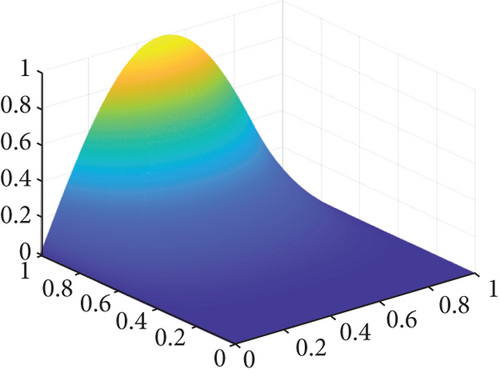

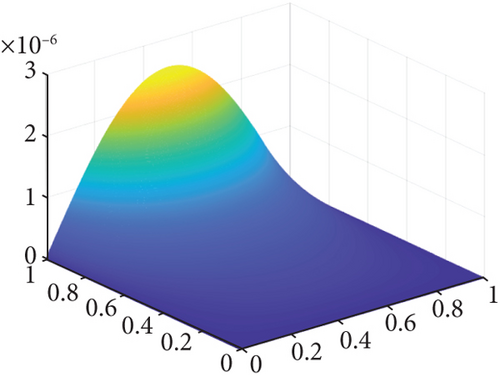
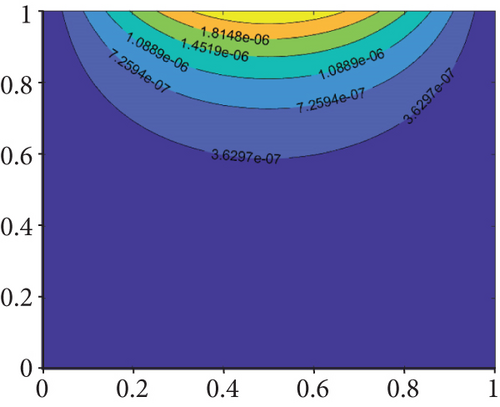
Then the corresponding initial term is u(x, 0) = sin(πx), and the exact solution is u(x, t) = sin(πx) − t4sin(2πx).
In Figures 2(a) and 2(b), we show the errors in L∞-norm attain second order of accuracy in temporal direction for β = 0.2 and β = 0.5, respectively. In Figures 2(c) and 2(d), we show the errors in L∞-norm attain second order of accuracy in spatial direction for β = 0.2 and β = 0.5, respectively. It is observed that the convergence order in the temporal and spatial directions are O(τ2) and O(h2), respectively, which are almost as the theoretical results in Theorem 7.
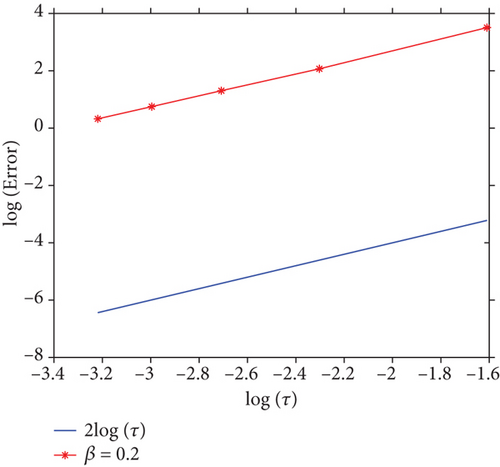
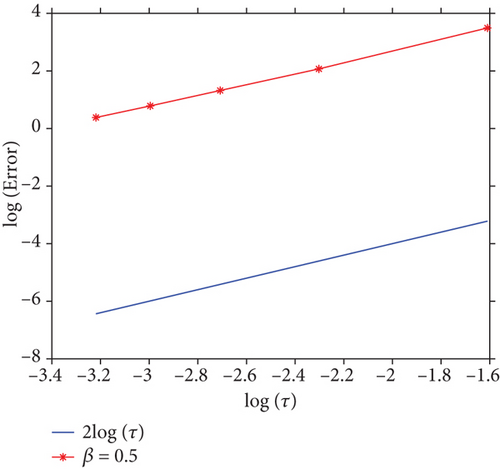
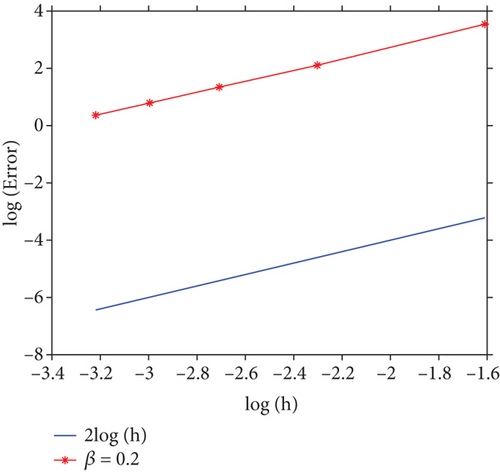
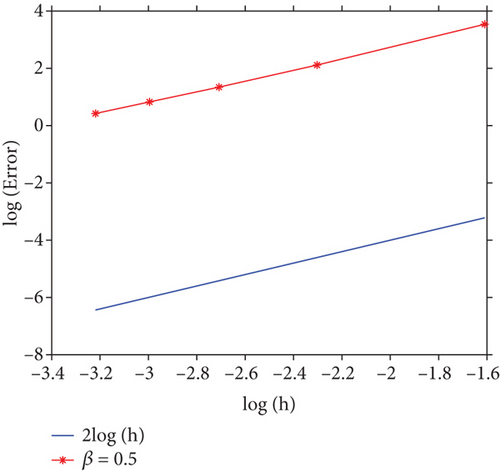
6. Conclusion
In this paper, we present two-level mesh method based on finite difference scheme to solve partial integro-differential equation. For the first step on coarse grid, we use finite difference method in time and global radial basis function finite difference in space. For the second step on fine grid, the finite difference method is used to solve the proposed problem, and the numerical solutions obtained by first step will be used as the initial conditions. The stability and error are discussed, and the convergence rate is obtained. Numerical examples show the efficiency of proposed scheme. It shows that the numerical results are in good agreement with theoretical analysis.
In our future work, we will study the numerical scheme of fractional derivatives, such as Riemann-Liouville derivative, Caputo derivative, and Caputo-Fabrizio derivative. Meanwhile, we would like to investigate fractional derivative in both time and space. In addition, we are interested to combine other numerical methods and RBF to consider the numerical solutions of high dimensional fractional integro-differential equations, irregular region problems, and nonlinear problems.
Conflicts of Interest
The authors declare that they have no conflicts of interest.
Acknowledgments
We are very grateful to both referees for carefully reading the paper and the most valuable comments and suggestions. This work is supported by the National Natural Science Foundation of China (No. 11861068), the Science Foundation for Distinguished Young Scholars of Xinjiang, China (No. 2022D01E13), and the Scientific Research Foundation for Outstanding Young Teachers of Xinjiang Normal University, China (No. XJNU202012).
Open Research
Data Availability
Data sharing not applicable to this article as no datasets were generated or analysed during the current study.




